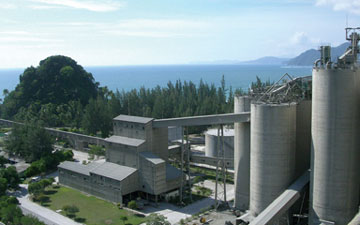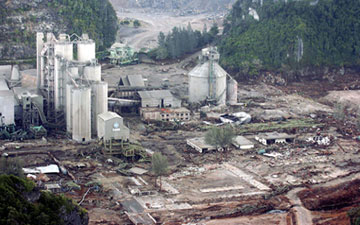SOUTHEAST ASIA
Cementing Recovery
|
| I |
t is not uncommon for industrial development to encounter forgotten cemeteries in the course of site evaluation and excavation. But in southeast Asia, the December 2004 tsunami made burial grounds out of every kind of property, including industrial sites themselves.
Even in a land torn by civil unrest, Indonesians have long used the expression gotong-royong (literally, "to carry a heavy burden together") to signify the priority of mutual cooperation over individual gain. That priority was never more apparent than in the tsunami's wake, and has been central to the family of recovery projects launched by Lafarge SA.
 |
| FROM CALM TO CHAOS:
Lafarge's P.T. Semen Andalas industrial site in Indonesia (pictured above before the December 2004 tsunami) saw 193 of its own employees perish among the 185,000 who died in the Aceh region alone. A US$90-million investment in a new cement plant is just a small part of what Lafarge and many partner organizations are doing to help the region get back on its feet. Photos courtesy Lafarge |

|
A US$90-million investment in a new cement plant is central to the plan, but it's by no means at the heart. Faced with a calamity unprecedented in modern times, the company is balancing business concerns with the fate of a washed- away community. The scope of its investment thus includes the building of 500 new houses at a cost of $6 million; mosque, health clinic and school reconstruction; training and education funding and the career placement needs of those who don't want to come back to Banda Aceh.
"We have long been present in Indonesia, and today, beyond from the emergency situation, we would like to support affected populations and help contribute to economic development in this country, which is very needy in terms of reconstruction," said Bernard Kasriel, at the investment announcement in July 2005.
First came search and rescue, as Lafarge dealt with the loss of 193 of its own 635 employees. In the Aceh region, some 185,000 people perished, out of 286,000 estimated casualties along all coasts of the Indian Ocean. Managing the situation from Djakarta and Medan, Lafarge was chartering two daily flights to the site within 48 hours of the disaster. Local cement distributors volunteered to transport supplies from Medan, where Lafarge leased a 450-person residential center to house surviving employees and their families. By February, a new center with 500 beds had been set up in Aceh.

